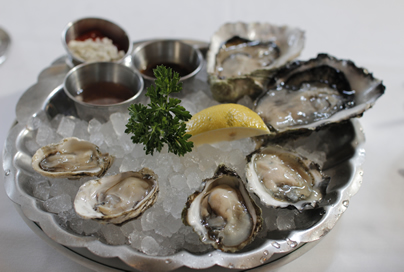News
Cooking with herbs
Monday, September 10th, 2012
Culinary herbs have traditionally been popular in Mediterranean, European and Asian cooking, but – happily for us – many of them have found their way into South African kitchens and cuisine. While some of these leaves, stems and flowers can enhance a variety of ingredients, each herb’s distinctive flavour profile has its preferred partner, like cream, tomatoes or garlic.
Even if you’re not fortunate enough to have a herb garden (like the impressive octagonal one at Vergelegen Wine Estate), it’s quite simple to buy bunches of fresh herbs from the market, or dried ones in bottles from good old Robertsons.
But what goes with sage, how should you make the most of mint or dill, and is oregano really more pungent when dried? We find out the finer points of cooking with herbs.
Basil
The distinctively fresh flavour of basil pairs perfectly with tomatoes for pasta sauces or pizza toppings, and can be blitzed into a versatile pesto with olive oil, pine nuts and pecorino. Try this red pesto with roasted tomatoes, red peppers and basil, chilled tomato and basil soup or pan pizza.
Chives
The hollow stems of chives have a great sharpness when sliced into your omelette, snipped into soups, or chopped up into creamy dips. Try chives in this simple feta tart or this Asian brown rice and ostrich salad.
Coriander / cilantro / dhania
These dainty fragrant leaves and stems are featured in the cuisine of China, Southeast Asia, South America and Mexico. Coriander is popular in soups, noodle dishes and marinades, and is used to temper spicy curries. Try it in this fresh carrot and coriander soup, Reza Mahammad’s chicken with apricots or Brad Ball’s spicy pad Thai.
Dill
The fresh fine leaves of dill are used to flavour fish, creamy sauces and pickles. It is particularly popular in Scandinavian and Russian cooking. Use dill in these beetroot and feta pitas.
Mint
Probably the most recognisable herb, fresh mint leaves are beautiful with fruit and vanilla cream for dessert, or in soothing herbal teas. Mint sauce is a staple with roast lamb, and also works well with Greek dishes and in creamy yoghurt sauces. Try this pea dip with asparagus wrapped in trout, zingy grilled cling peach and pea salad or this classic rack of lamb with roast potatoes and vegetables.
Oregano
Also known as wild majoram, oregano has a pungent taste that’s important in Italian cooking. Pizzas, pastas and especially tomato dishes make use of fresh or dried oregano (it’s stronger when dried). Rub it on fish or lamb with some olive oil before roasting, or try one of these hearty recipes: chicken with smoked paprika, bacon and white beans, lamb ribs with Moroccan spices, and sweet potato gnocchi with shredded lamb.
Parsley
Curly leaf parsley is often relegated to the sad role of garnish on a side plate, while the flat leaf variety is slightly more hip and more flavoursome. Parsley is commonly used in Middle Eastern cooking with its good friends, garlic and lemon. Add the chopped leaves to soups and meaty stews (right at the end) for some freshness. You can use parsley and yoghurt for a creamy dressing for this smoked mackerel, broccoli and quinoa salad, in this simple chicken pie, or apple-stuffed pork chops and Parmesan-crumbed lamb chops. For something a little more zingy, use parsley in plum and feta tabouleh or pan-fried courgette flowers with goat’s cheese stuffing.
Rosemary
The strong flavour of rosemary is brilliant with robust roasts, marinades, game and potatoes. Used it fresh or dried. Experiment with sautéed rosemary potatoes with cherry tomatoes and black olives, grilled lamb cutlets or this classic roast leg of lamb.
Sage
Aromatic sage has a slightly peppery flavour, with is especially good with cream, fatty meats and marinades. Whole leaves are used fresh, or can be fried in butter to give character to pasta. In Italian cooking sage is common in saltimbocca and minestrone; in Britain the herb is popular in pork and poultry stuffing. Try these great vegetarian dishes: rich butternut and sage gratin, gnocchi with burnt sage butter or mushrooms with blue cheese and sage polenta.
Tarragon
This herb is used mostly in French cuisine for its aniseed-like flavour to complement chicken, fish and egg dishes. Tarragon vinegar is delicious in salads, pickles and sauces, and the leaves are famously good with cream and mushrooms to accompany steak. Leaves can be used fresh, freeze-dried or simply air-dried. Try tarragon in these prosciutto-and-basil-wrapped prawn tails.
Thyme
These tiny leaves (fresh or dried) contain essential oil, which lends thyme its aromatic odour. Use it in a bouqet garni or for stuffing, stews, casseroles, soups and baked fish. Wild thyme goes particularly well with chicken. Try this traditional coq au vin or beef fillet with wild mushrooms and red wine butter sauce. For something less meaty, make this baby beetroot, blue cheese and walnut risotto or stuffed red onions with garlic croutons.
By Linda Scarborough
Want to grow your own? Here’s how to start your own veggie or herb garden.
Want to get a little more bold with blossoms? Read our story on the latest trend of cooking with flowers.











